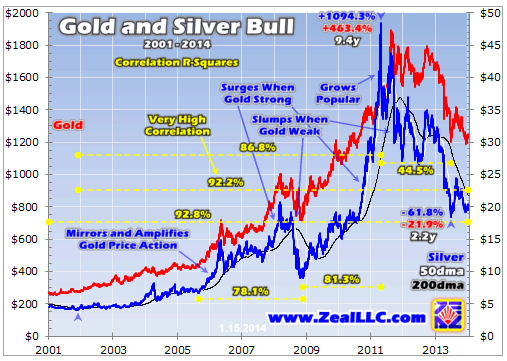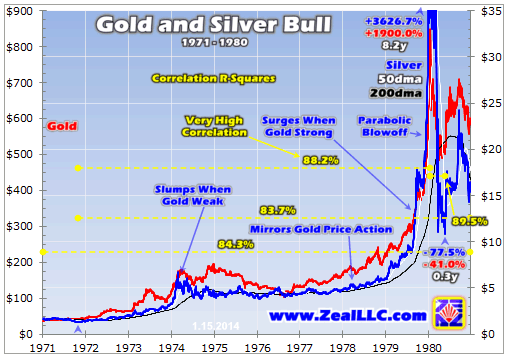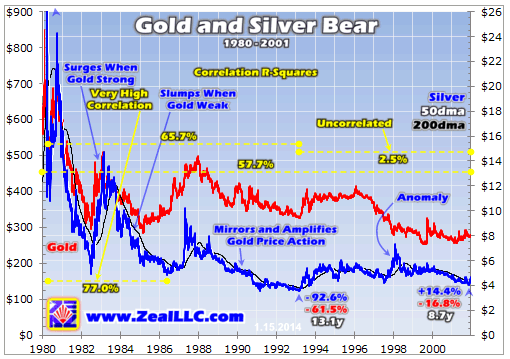Investors’ interest in silver is starting to rebound after last year’s carnage. As capital prepares to return to this beaten-down asset, many investors are wondering how to game silver price action. Gold is the key. The white metal closely mirrors and amplifies the price action in the yellow one. Gold is not only silver’s primary driver, but its overwhelmingly dominant one. Gold is critical for timing silver buying and selling.
The more years you spend trading precious metals, the more self-evident this truth becomes. Gold drives silver, full stop. After my 14 years of closely watching gold and silver price action in real-time all day every day, I simply take this ironclad relationship for granted. I can scarcely even write about silver without mentioning it in passing. Gold drives silver is a core trading axiom much like buy low sell high.
Silver looks extraordinarily bullish in 2014, from multiple perspectives discussed in my latest few essays. In each of them I peripherally mentioned gold drives silver, which is like saying the sky is blue. So I’ve been very surprised by feedback on this fact ranging from incredulity to hostility. Some don’t believe it, others challenge me to prove it, and a few are angered by the affront silver is mostly dependent on gold.
In defense of the latter, sometimes I mischievously provoke the hardcore silver zealots with flippant comments like calling silver “gold’s little lapdog”. They just love that! But the hard math of market history doesn’t lie, gold drives silver to a massively dominant degree. Silver is effectively a leveraged play on gold, just like the gold stocks. This critical truth is supported by extensive historical underpinnings.
The silver price is highly correlated with gold, which no one will dispute. These precious metals move in unison the vast majority of the time. While this is readily evident observationally to veteran investors, it is also absolutely provable statistically. Correlation coefficients are the constructs that mathematically quantify the relationships between two data series, such as the price of silver and the price of gold.
Technically correlation coefficients are derived from dividing the covariance (how data changes together) of two variables by the product of their standard deviations. If that sentence didn’t make your eyes glaze over, you’re a better man than me. Thankfully this tedious underlying math is automated through modern computer spreadsheets. Microsoft Excel’s CORREL function does all the heavy lifting.
Statisticians label the resulting correlation coefficient as “R”. But that’s not quite enough for investors to risk capital on. Multiplying the correlation coefficient by itself yields a second construct called the coefficient of determination, or “R-squared”. This reveals the actual percentage of any price’s movement that is statistically explainable by a second price’s action. I bastardize this label to “r-square” in my work.
So if silver and gold have a 0.9 correlation coefficient, squaring that yields an r-square of 81%. 81% of the price action in one is directly explainable by the price action in the other. In this example, just 1/5th of either one’s price action is independent of the other’s. Over time achieving success in investing demands making high-probability bets, so if an r-square is high enough the residual is largely irrelevant.
As statisticians love to point out, correlation does not imply causation. Silver and gold are indeed highly correlated, their price action deeply interrelated. So mathematically at least, the case for silver driving gold is equal to the one for gold driving silver. Maybe silver is actually the dominant metal, and gold simply follows it! But of course this makes little sense fundamentally or practically, gold dominates silver.
The global gold market is orders of magnitude larger than silver’s, gold trading dwarfs silver trading. All over the world, traders are quick to buy and sell gold based on stock-market performance, economic data, and central-bank actions. The tiny highly-speculative silver market just follows along for the ride. If you watch silver futures very closely in real-time, there is a seconds-to-minutes delay after gold moves.
Silver is a speculators’ playground dominated by greed and fear. Silver traders watch gold closely for their trading cues. They grow bullish and greedily buy silver when gold is strong, so silver follows and amplifies gold’s upside. Then they wax bearish and rush to fearfully sell silver when gold is weak, so silver leverages gold’s downside. The giant gold market drives the tiny silver one, not the other way around.
Our charts this week offer the hard mathematical proofs of silver’s near-total dependence on gold. They show silver prices superimposed over gold’s during their last secular bulls and bear. Correlation r-squares derived from Excel’s CORREL function over key spans for silver are shown in yellow. You can easily replicate these results with your own daily closing data if you feel the need to verify this truth.
In recent weeks’ essays on why silver is so incredibly bullish this year, I mentioned in passing that gold is responsible for over 92% of silver’s price action in its entire secular bull. That was stealthily born over a dozen years ago in November 2001 when silver traded just above $4. That very bottoming month was when we first started recommending physical silver as an investment for our newsletter subscribers.
If you take every daily silver and gold close since then, all 3059 trading days, and have Excel calculate the correlation coefficient between these two prices, it runs 0.9602. Multiplying that by itself yields an r-square of 92.2%. That is staggeringly high over such a long span of time. Around 12/13ths of all silver’s price behavior on a closing interday basis over the past dozen years is a direct function of gold’s own!
Gold drives silver, it is the key to understanding where silver is going. Gold dominates sentiment among silver traders, so they almost always buy and sell in lockstep with gold. And if gold can mathematically explain 12/13ths of silver’s price action, then everything else including silver’s fundamentals effectively only accounts for 1/13th. In probability terms, that is negligible. Investors need to bet on the dominating odds.
So if you are trying to buy silver low to later sell high, and your research on timing is so silver-centric it ignores gold, you are wasting your time. Don’t get mad at me, that’s the cold, hard truth of market history. I myself sometimes wish silver was less correlated with gold than it is, that silver futures traders weren’t so darned preoccupied with gold futures. There are times when gold vexingly holds silver back, like 2013.
I ran gold/silver correlations for other key periods too, such as silver’s entire secular bull up to its dazzling April 2011 peak. That was the last time silver was growing popular, and boy was it fun. Silver’s r-square with gold still ran a very high 86.8% over that span. You can further dissect silver’s massive bull into a two major runs, from late 2005 to the late-2008 stock-panic low and from there to early 2011’s heights.
Silver’s correlation r-square with gold ran 78.1% and 81.3% over those critical spans for silver investors. So at very worst, fully 4/5ths of silver’s incredible bull-market surges that earned fortunes for us and our subscribers were statistically explainable by gold’s own secular bull! Gold drives silver. That’s why I’ve always devoted way more time to studying gold, it is the key to understanding silver and gaming its moves.
Provocatively in last year’s epic carnage, the worst year for both gold and silver in nearly a third of a century, this correlation really moderated. The gold/silver r-square between silver’s bull-to-date peak in April 2011 and its brutal June 2013 low was just 44.5%. Silver was moving more independently relative to gold than usual. And that may be why the gold-drives-silver truth is somewhat controversial today.
A couple factors explain this temporary reprieve in gold’s crushing dominance over silver. Back in early 2011, silver had skyrocketed in a near-parabolic ascent threatening to become a mania. It was wildly overbought as I warned just before that topping, and needed to correct sharply to rebalance sentiment. And it did, with silver soon plummeting in one of its characteristic near-crashes. This wasn’t gold’s fault.
Gold was not too overbought at that point, although it would later follow in the late summer of 2011. The extreme greed that drove silver’s massive early-2011 gains had to be neutralized by the great sentiment pendulum swinging the opposite way to extreme fear. So silver corrected on its own accord, although the daily gold action still affected the pace of this enormous correction. And then 2013’s anomaly arrived.
Gold plummeted last year because the Fed-driven levitation in the general stock markets sucked capital and interest away from alternative investments. American stock investors dumped GLD gold-ETF shares so fast that the resulting flood of gold supply exceeded the rest of the world’s gold demand growth. This crushed gold prices and silver was sucked into that brutal once-in-a-lifetime perfect storm of selling.
But unlike GLD, the flagship SLV silver ETF did not suffer heavy differential selling last year. So silver was far more resilient than it had any right to be in such a horrendous year for gold. This SLV bullish divergence weakened gold’s stranglehold on silver last year. But with silver’s epic correction over, and GLD selling reversing as the greatly-overvalued stock markets top, the usual gold/silver relationship should resume.
Some investors have been wondering if silver’s super-high correlation with gold is something new in today’s secular bull. Was silver’s last secular bull also dominated by gold in the 1970s? Yes it was. This next chart applies the same correlation analysis back then. Though silver peaked at a then-astounding $48 in January 1980, I lopped off those fleeting highs to better show silver’s action leading up to them. 
Between November 1971 and January 1980 when silver blasted parabolic in a full-blown popular mania, its correlation r-square with gold was 88.2%. Over 7/8ths of all silver’s price action in that entire secular bull was directly explainable by gold’s own! That was actually a little higher than the 86.8% seen in today’s secular bull up to silver’s April 2011 peak. Gold has always dominated silver, it’s nothing new.
This was also true during the post-parabola silver crash in 1980, when silver plummeted 77.5% in just 4 months! That made 2013’s carnage look like playschool. Yet despite silver’s parabola being far more extreme than gold’s, the gold-price action still mathematically explained 89.5% of silver’s. Gold drives silver. Silver traders watch gold for their trading cues, and then simply mirror whatever gold is doing.
It is absolutely essential to understand that this link is emotional, not fundamental. It’s greed and fear, not supply and demand, that has inexorably linked silver with gold’s fate. Silver traders buy when gold is strong, and sell when gold is weak. Rational or not, since they have done this for so many decades and created such a stellar correlation this behavior is self-reinforcing. We have no choice but to ape it.
Does gold’s dominance over silver extend back before the 1970s? I don’t know. My daily gold and silver price data only goes back to June 1969. I’ve searched occasionally over the years for an older daily dataset, but still haven’t found one. If I had one, I’d certainly do the analysis. But I strongly suspect that data before August 1971 is irrelevant. That of course marks the most important gold event in US history.
Prior to then, US dollars were fully convertible into gold. With the US government legally fixing the dollar gold price, we were on a gold standard. Whenever gold threatened to decouple from its set dollar price, big players could arbitrage any differences by trading dollars for gold or vice versa with the US Treasury. So gold volatility in dollar terms was vastly lower before 1971, nonexistent by today’s standards.
The century-long silver price charts I’ve occasionally seen show silver prices usually tracking gold pretty closely, with little volatility before Richard Nixon “temporarily” suspended the gold standard in August 1971. There is no comparability across that vast discontinuity, the gold-standard and post-gold-standard eras are day-and-night different. So I suspect pre-1971 silver-price action has zero lessons for today.
But between silver’s two mighty secular bulls of the 1970s and 2000s, there was a massive secular bear. To complete this gold/silver correlation analysis, I ran some numbers over that span too. Even then, silver remained highly correlated with gold during the great majority of that span. Silver’s big moves still mirrored gold, as you can see visually in this chart. But there was a peculiar long uncorrelated span. 
Technically silver’s secular bear ran for 13 years between January 1980 and March 1993, although after that silver essentially just ground sideways until November 2001. During that secular-bear-proper span, silver’s correlation r-square with gold was 65.7%. Fully 2/3rds of all silver’s secular-bear price action was directly explainable by gold’s own. And during the worst of that bear, the correlation was even higher.
The lion’s share of silver’s post-parabola losses happened by silver’s May 1986 low. In that span silver’s r-square with gold was 77.0%. Gold drove over 3/4ths of silver’s price action! So even in secular bears, silver traders still key off gold for their buying and selling decisions. Gold drives silver, through bull and bear alike. You can’t understand silver, nor hope to trade it successfully, unless you really study gold.
After silver’s absolute bear-market low in early 1993, this metal spent the next 9 years or so just grinding sideways near lows. Amazingly silver was almost totally uncorrelated with gold over this span, having an r-square with gold of just 2.5%! For a variety of reasons beyond the scope of this essay, silver was actually trading on its own psychology and fundamental merits then. But that episode was an anomaly.
My gold-and-silver daily-closes dataset encompasses 44.7 years since 1969, a heck of a long time. And even including that 8.7-year uncorrelated span deep in a secular-bear wasteland, the overall correlation r-square of silver and gold was 85.1%! That is over 11,263 trading days. Across that enormous secular sea encompassing everything imaginable, nearly 6/7ths of silver’s price action was driven by gold.
So it seems prudent to continue to expect gold to dominate silver sentiment and therefore silver prices in the years to come. The historical market performance and data is crystal-clear, gold drives silver. Silver investors need to keep this in mind. Silver is a fascinating metal to study, with its own independent global supply-and-demand fundamentals. Yet technically it has always been slave to gold’s fortunes.
Silver is effectively a leveraged play on gold, the vast majority of its performance can be mathematically explained by gold’s own. Thankfully gold is due for a massive mean-reversion rebound upleg in 2014 as the stock markets roll over and extreme GLD differential selling reverses. This coupled with silver’s technical launchpad, record futures shorting, and SLV resilience positions silver for a huge upleg this year.
The highest-potential way to ride silver’s recovery is through silver stocks. These miners and explorers were beaten down to fundamentally-absurd levels in last year’s carnage. The best of them are poised to skyrocket as silver recovers.
The bottom line is gold drives silver. For the entire four decades of the post-gold-standard era, the vast majority of silver’s price action has been statistically explainable by gold’s own. This happened in bull and bear markets alike. Silver has always been a highly-speculative market where greed and fear reign supreme, and these buying-and-selling emotions have always piggybacked off the fortunes of gold.
Since gold is silver’s overwhelmingly dominant driver, silver can only be successfully traded by studying gold. The time to buy silver is when gold is on the verge of a major upleg. That’s when capital will start returning to silver and eventually drive outsized gains leveraging gold’s. And since 2014 is due to be an awesome year for gold as it mean reverts higher, silver is destined to enjoy one heck of an upleg this year.
- English (UK)
- English (India)
- English (Canada)
- English (Australia)
- English (South Africa)
- English (Philippines)
- English (Nigeria)
- Deutsch
- Español (España)
- Español (México)
- Français
- Italiano
- Nederlands
- Português (Portugal)
- Polski
- Português (Brasil)
- Русский
- Türkçe
- العربية
- Ελληνικά
- Svenska
- Suomi
- עברית
- 日本語
- 한국어
- 简体中文
- 繁體中文
- Bahasa Indonesia
- Bahasa Melayu
- ไทย
- Tiếng Việt
- हिंदी
Is Gold Driving Silver?
Published 01/17/2014, 01:12 PM
Updated 07/09/2023, 06:31 AM
Is Gold Driving Silver?
Latest comments
Loading next article…
Install Our App
Risk Disclosure: Trading in financial instruments and/or cryptocurrencies involves high risks including the risk of losing some, or all, of your investment amount, and may not be suitable for all investors. Prices of cryptocurrencies are extremely volatile and may be affected by external factors such as financial, regulatory or political events. Trading on margin increases the financial risks.
Before deciding to trade in financial instrument or cryptocurrencies you should be fully informed of the risks and costs associated with trading the financial markets, carefully consider your investment objectives, level of experience, and risk appetite, and seek professional advice where needed.
Fusion Media would like to remind you that the data contained in this website is not necessarily real-time nor accurate. The data and prices on the website are not necessarily provided by any market or exchange, but may be provided by market makers, and so prices may not be accurate and may differ from the actual price at any given market, meaning prices are indicative and not appropriate for trading purposes. Fusion Media and any provider of the data contained in this website will not accept liability for any loss or damage as a result of your trading, or your reliance on the information contained within this website.
It is prohibited to use, store, reproduce, display, modify, transmit or distribute the data contained in this website without the explicit prior written permission of Fusion Media and/or the data provider. All intellectual property rights are reserved by the providers and/or the exchange providing the data contained in this website.
Fusion Media may be compensated by the advertisers that appear on the website, based on your interaction with the advertisements or advertisers.
Before deciding to trade in financial instrument or cryptocurrencies you should be fully informed of the risks and costs associated with trading the financial markets, carefully consider your investment objectives, level of experience, and risk appetite, and seek professional advice where needed.
Fusion Media would like to remind you that the data contained in this website is not necessarily real-time nor accurate. The data and prices on the website are not necessarily provided by any market or exchange, but may be provided by market makers, and so prices may not be accurate and may differ from the actual price at any given market, meaning prices are indicative and not appropriate for trading purposes. Fusion Media and any provider of the data contained in this website will not accept liability for any loss or damage as a result of your trading, or your reliance on the information contained within this website.
It is prohibited to use, store, reproduce, display, modify, transmit or distribute the data contained in this website without the explicit prior written permission of Fusion Media and/or the data provider. All intellectual property rights are reserved by the providers and/or the exchange providing the data contained in this website.
Fusion Media may be compensated by the advertisers that appear on the website, based on your interaction with the advertisements or advertisers.
© 2007-2024 - Fusion Media Limited. All Rights Reserved.
